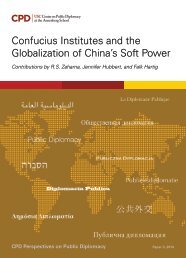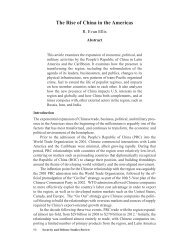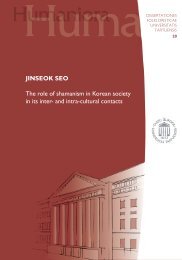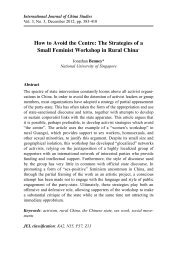JennyChan.PhDThesis.2014.FINAL
JennyChan.PhDThesis.2014.FINAL
JennyChan.PhDThesis.2014.FINAL
You also want an ePaper? Increase the reach of your titles
YUMPU automatically turns print PDFs into web optimized ePapers that Google loves.
classified as rural residents, including those who have lived and worked in cities for<br />
years, and indeed some were born and have spent their entire lives in cities. Recent<br />
government statistics indicate that nearly 30 million rural workers had migrated to<br />
urban areas with their spouse and children, 127 and this trend of family out-migration<br />
continues. State provision of contract land for rural residents, including migrants<br />
living and working in the cities, could arguably facilitate national development and<br />
stabilize society while preserving a vast proto-peasantry. 128 The original state-led<br />
accumulation strategy, based on the calculation that reproduction of villagers,<br />
including raising and educating children and eventual retirement, would take place in<br />
the rural areas, has been extended to the present, that is, to a time when hundreds of<br />
millions of migrant laborers have left the countryside for the cities under China’s<br />
capitalist transition.<br />
However, the desirability and sustainability of young people living in the traditional<br />
mode of rural-based social reproduction of labor is highly questionable. Rural<br />
migrants find themselves caught in a position of incomplete proletarianization. 129<br />
The primary income of the scores of migrant factory workers is derived from wage<br />
labor. In the urban workplace, employers pay rural migrant labor less than their local<br />
counterparts, on the dubious assumption that the village will provide subsistence,<br />
housing, and security in old age. 130 Based on the 2010 Chinese trade union survey,<br />
the surveyed 2,711 migrant workers (from 1,000 unionized enterprises covering<br />
state-owned, collective, domestic private, and foreign-invested enterprises) were<br />
paid less on all five categories of insurance and the housing provident fund than<br />
co-workers with urban hukou. Perhaps surprisingly, significant numbers of local<br />
workers lacked one or more mandated social insurance benefits at the time of the<br />
127 National Bureau of Statistics of the People’s Republic of China, 2010, “2009 ian ongmingong<br />
Jiance Diaocha Baogao” (Monitoring and Investigation Report on the Rural Migrant Workers in 2009)<br />
2009 年 農 民 工 監 測 調 查 報 告 .<br />
http://www.360doc.com/content/13/1016/14/7157405_321860376.shtml<br />
128 Tiejun Cheng and Mark Selden, 1994, “The Origins and Social Consequences of China’s Hukou<br />
System,” The China Quarterly 139, pp. 644-68; Mark Selden and Wu Jieh-min, 2011, “The Chinese<br />
State, Incomplete Proletarianization and Structures of Inequality in Two Epochs,” The Asia-Pacific<br />
Journal Vol. 9, Issue 5, No.1, January 31. http://japanfocus.org/-Mark-Selden/3480#; Dorothy J.<br />
Solinger, 1999, Contesting Citizenship in Urban China: Peasant Migrants, the State, and the Logic of<br />
the Market, Berkeley: University of California Press; Martin King Whyte, 2010, “The Paradoxes of<br />
Rural-Urban Inequality in Contemporary China,” One Country, Two Societies: Rural-Urban<br />
Inequality in Contemporary China, edited by Martin King Whyte, Cambridge, Massachusetts:<br />
Harvard University Press, pp. 1-25.<br />
129 Pun Ngai and Lu Huilin, 2010, “Unfinished Proletarianization: Self, Anger and Class Action of<br />
the Second Generation of Peasant-Workers in Reform China,” Modern China 36(5), pp. 493-519.<br />
130 For an excellent discussion on rural migrant labor and social inequality in other national context,<br />
see Michael Burawoy, 1976, “The Functions and Reproduction of Migrant Labor: Comparative<br />
Material from Southern Africa and the United States,” American Journal of Sociology 81(5), pp.<br />
1050-87.<br />
34






